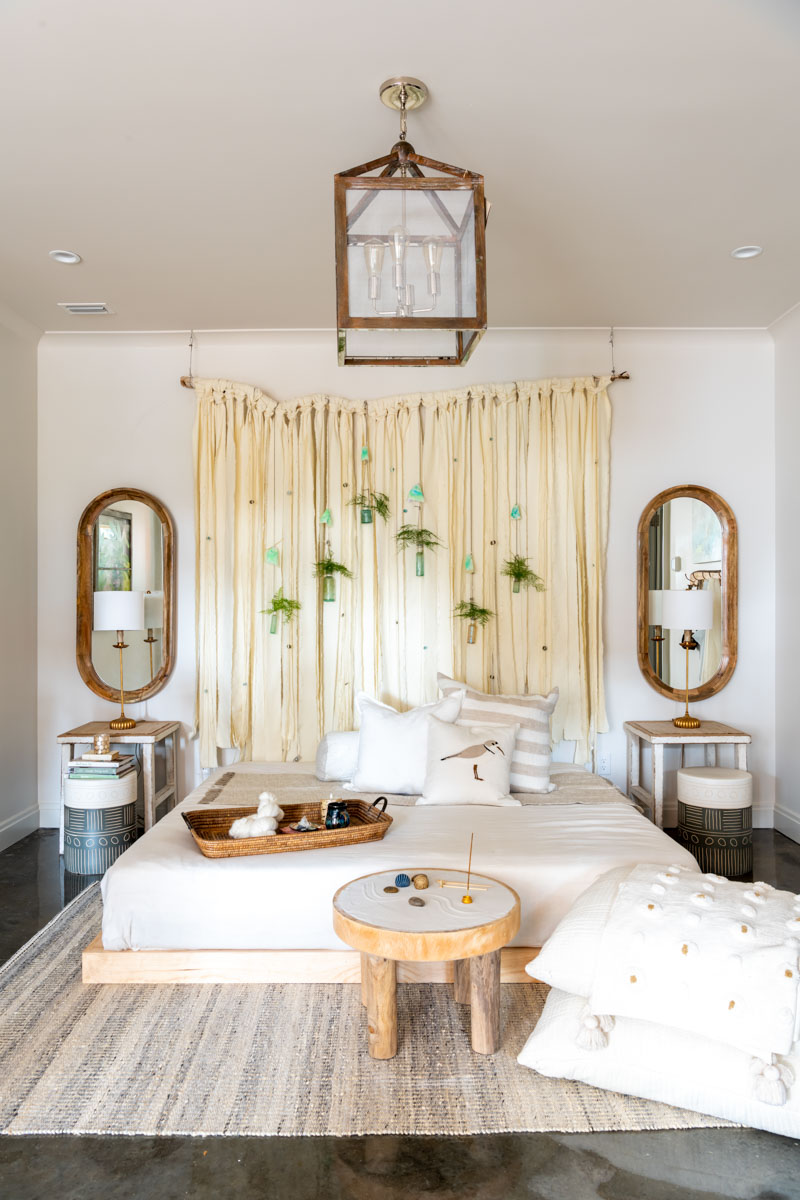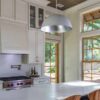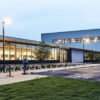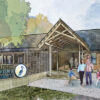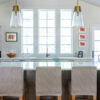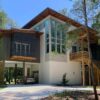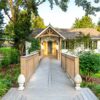Flex Studio

Sustainable Design Strategies
Planning and Design
![]()
The flex studio contains many of the amenities that a homeowner might seek in a “carriage house” or garage apartment. Because this lot sloped 10’ from street to rear, we were able to tuck these spaces under the home, preserving more landscape for enjoyment, and minimizing impervious surfaces and associated stormwater runoff.
One of the mantras of sustainable design is “long life, loose fit.” Highly specialized spaces for specific functions can become obsolete over time, making it more difficult and resource intensive for the building to be used for 50 or 100 years. The studio is designed to adapt to a family’s changing needs over time. It can be fitted out as a home office, play room, media room, or converted to a separate living space for a caretaker or family member. Infrastructure has been provided for a hotel style kitchenette to be fitted out along the West wall, and a full washer dryer to be provided in the Utility Room. The full bath is accessible from the interior of the Flex Studio and can be closed off from the Entry Hall for privacy if desired.
Concrete Walls and Floor
![]()
In the Flex Studio and Utility room the structural concrete slab has been polished and sealed as a finished floor. This helps to conserve materials by eliminating the need for an additional floor finish. Unlike most concrete buildings in our area, these concrete walls are insulated on the exterior only. On the interior they are simply covered in drywall. This allows their significant mass to serve as a thermal “sink” holding heat in reserve and slowly releasing it, and moderating the temperature of the ground floor.
Concrete is the most widely used man-made material in existence. It is second only to water as the most-consumed resource on the planet. But, while cement – the key ingredient in concrete – has shaped much of our built environment, it also has a massive carbon footprint. In order to reduce the carbon impact of the cement in the foundation and walls of the Inspiration Home, we used a low carbon mix that substitutes a recycled pozzolan for 40% of the portland cement, greatly reducing the carbon footprint of the concrete.
People tend to think of the environmental impact of a home or building in terms of energy use and utility bills. However, building materials also create significant environmental impacts, through the pollution associated with their extraction, manufacture, and transportation to the job site. This is called “embodied carbon,” with carbon being an indicator of all greenhouse gases, not just carbon dioxide. The environmental impacts of building materials are also front loaded in time, while a building’s energy use creates incremental impacts over a lifetime of use. Since the emissions that we produce between now and 2050 will determine whether or not we avoid the worst impacts of climate change, the embodied carbon of building materials matters a great deal.
For the greatest impact, prioritize the selection of locally produced and sustainably manufactured materials for heavy items that are needed in large quantities, like brick, concrete, framing, or drywall.
Energy Efficient Ceiling Fan
![]()
The Wrap fan by Fanimation is on Energy Star’s list of their “Most Efficient” certified fans. The curved shape of the blades reinforces the cooling sensation of air movement and the warmth of bamboo blades adds another biophilic element to the fixture. Fans save energy by expanding your perceived comfort range with the cooling sensation of air movement, without actually having to change the air temperature. In this setting, the fans help the space to function as supplemental outdoor living or work space.
Because our bodies evolved in natural settings with varied temperature, light conditions, and air movement, we still respond favorably to the environment with those characteristics. Rooms where people can fine tune their thermal conditions with a ceiling fan have been shown to provide a more pleasurable indoor experience than rooms with uniform temperatures throughout and no movement. The fans bring the feeling of a bay breeze, indoors.
UltraLight Gypsum Drywall
![]() US Gypsum USG Sheetrock® Brand UltraLight Panels are Greenguard Gold certified, low emitting materials. Sheetrock is ubiquitous in construction, it is a heavy material used in large quantities. Using light weight drywall is a simple step that greatly reduces the pollution associated with transporting the materials from manufacture to the site.
US Gypsum USG Sheetrock® Brand UltraLight Panels are Greenguard Gold certified, low emitting materials. Sheetrock is ubiquitous in construction, it is a heavy material used in large quantities. Using light weight drywall is a simple step that greatly reduces the pollution associated with transporting the materials from manufacture to the site.
USG Sheetrock® Brand UltraLight Panels are 1/2 in. (12.7 mm) gypsum panels that feature proprietary core and paper technologies, resulting in a high strength-to-weight ratio composite design. These lightweight panels are also engineered to have superior sag resistance, eliminating the need for traditional 1/2 in. (12.7 mm) sag-resistant ceiling panels. The noncombustible gypsum core is encased in 100% recycled face and back papers, The light weight design is easier for installers to work with, and can improve construction speed and safety.
People tend to think of the environmental impact of a home or building in terms of energy use and utility bills. However, building materials also create significant environmental impacts, through the pollution associated with their extraction, manufacture, and transportation to the job site. This is called “embodied carbon,” with carbon being an indicator of all greenhouse gases, not just carbon dioxide. The environmental impacts of building materials are also front loaded in time, while a building’s energy use creates incremental impacts over a lifetime of use. Since the emissions that we produce between now and 2050 will determine whether or not we avoid the worst impacts of climate change, the embodied carbon of building materials matters a great deal.
For the greatest impact, prioritize the selection of locally produced and sustainably manufactured materials for heavy items that are needed in large quantities, like brick, concrete, framing, or drywall.
Wood Doors and Trim
![]() Solid wood doors and finger jointed molding use wood sourced from Koetter’s own managed forests that were planted from vacant land. Keotter has won multiple awards for forest management Including the “Good Steward” award from the Arbor Day foundation and the Forestry Award from the Indiana Wildlife Federation. Solid wood doors are naturally low emitting materials. Finger jointed molding conserves materials by utilizing smaller pieces of wood joined together.
Solid wood doors and finger jointed molding use wood sourced from Koetter’s own managed forests that were planted from vacant land. Keotter has won multiple awards for forest management Including the “Good Steward” award from the Arbor Day foundation and the Forestry Award from the Indiana Wildlife Federation. Solid wood doors are naturally low emitting materials. Finger jointed molding conserves materials by utilizing smaller pieces of wood joined together.
The curved shapes of moldings and door panels balance the strong lines of the cabinets. and reinforce the biophilic interior design, by echoing organic forms, like the curve of a wave or a seashell.
Interior Paint
![]() The interior paint is Greenguard Gold certified as a low emitting material, or has an equivalent certification with small chamber testing. This means that the paint has been tested in a sealed chamber where any off gassing can be analyzed and measured for compliance with health standards. This is not the same as being labeled “low emitting”. Many products are labeled “low emitting” that simply meet legal requirements for the volatile organic compounds in their ingredients. They may only be “low” compared to materials that are no longer legal to use, hardly something to brag about.
The interior paint is Greenguard Gold certified as a low emitting material, or has an equivalent certification with small chamber testing. This means that the paint has been tested in a sealed chamber where any off gassing can be analyzed and measured for compliance with health standards. This is not the same as being labeled “low emitting”. Many products are labeled “low emitting” that simply meet legal requirements for the volatile organic compounds in their ingredients. They may only be “low” compared to materials that are no longer legal to use, hardly something to brag about.
Indoor Air Plus certification requires that 90% of all paints, stains, and coatings applied inside the home meet GreenGuard Gold or an equivalent certification. Not only the paint, but also all of the stains, coatings, adhesives, sealants, and caulks in this home were carefully screened to prevent emissions that could contaminate the interior of this home.
All of the paint colors used in the Inspiration Home contain no black or grey pigment, which make them extremely dynamic and responsive to differing conditions of daylight. This mimics the dynamic appearance of colors found in nature and is one of our biophilic design strategies.

